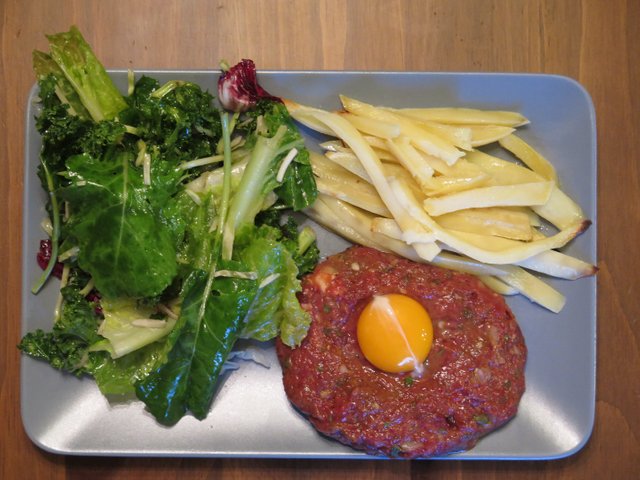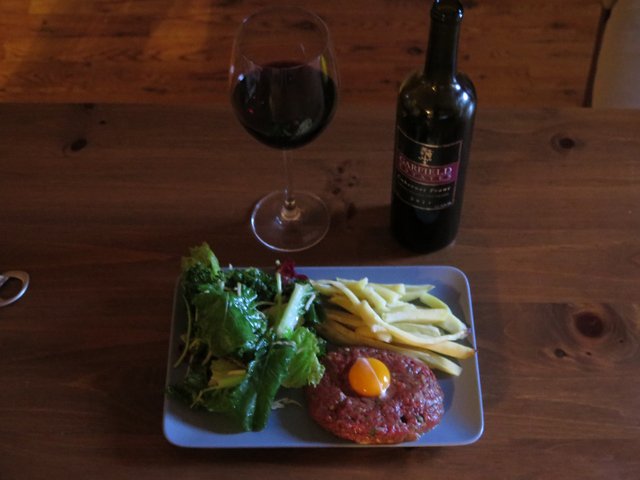Elk Tartare Notes
I have always found raw red meat appealing. I like my steak rare, and roast beef saignant. The thought of eating raw red meat in some form has always appealed to some inner primal sense. So I had to take it to the next level, and understand it further… steak tartare!

There is a subculture within the paleo diet scene that regularly eats raw meat. Claims of improved health by both Melissia Henig and Lex Rooker make complete sense to me. In the coming months I’ll consider the tradeoffs of cooking versus raw and and start introducing more raw food into my diet.
Steak tartare is a good place to start. It is rumoured to have come to western Europe from the Tartars, the nomadic descendants of the fierce Mongols running the Russian steppes. According to legend, to tenderize their meat they would cut it into fillets and place it under their saddles. These sagas most likely influenced the recipes of central and eastern Europe where it is still popular today In Poland it is known as "Befstyk Tartars"
As emigrants in the eighteenth century travelled from eastern Europe, crossed Germany and France, on their way to the new world, they brought with them their recipes including steak tartar. It started appearing on menus in Paris at the end of the 19th century. Tartare steaks have not been limited to beef. Horse tartare started being served in Paris during the 1870 Franco Prussian war. Today it maybe making a comeback as it is served in some of Paris’ trendy restaurants. It is a supposedly a lean meat that’s tender and loaded with minerals. Again the tales about the mongols eating their dying horses raw may have lead to the trend, but there is no proof. The restaurant “Les Tontons” in Paris serves horse steak tartare.
Beefsteack à l'Américaine as it was called at the beginning of the twentieth century in Paris, was served with a raw egg yolk atop the raw ground meat and with capers, chopped onion and chopped parsley on the side. Steak tartare was originally a derivative dish, named not for raw-meat-eating Tatars, but for the tartar sauce that was served with it. Tartar sauce had appeared earlier in the century and anything served with it was known as "à la tartare." Alexandre Dumas mentioned "goat à la tartare" in his 1846 novel, "The Count of Monte Cristo" and Honoré de Balzac wrote about "eel à la tartare" four years later, around the time of his death.
I was in Montreal recently and decided to check out the local paleo offerings. At the time, two restaurants kept making it to the top of the google search, Marché 27 and Au Pied de Cochon. I ordered a beef steak tartare at Marché 27, “ styles Français” served with sweet potato fries, and salad. The tartare was prepared with dijon, tabasco, capers, olive oil and red onions. It went down well with a glass of pinot noir.
The next evening I tried the bison tartare at Au Pied de Cochon. It too was served with salad and sweet potato fries. I think it was also accompanied by a pinot noir. It was a good evening. Based on this experience that I sought out a tartare recipe to prepare my elk tartare at home.
Eating game I harvested added a personal and regional aspect to the experience. In my mind this was taking the paleo diet to the next level. Wild elk is grass, leaf, and sage brush fed. No time in the yards or feedlots.
For this recipe I used some of my elk harvested in the fall. I picked a chunk of rear hip, or round steak. It had been frozen for well over two months, killing any parasites that may have existed.
I prepared the marinade a full day before, and let it sit in the refrigerator. I let the meat thaw and then cut out a piece of meat that was not exposed. Bacteria form on the outside of the meat, which is why when I cook my steaks I just cook the two sides. I cut out about a 1 ½ lbs piece and cut it up into smaller pieces. I then ran it through the food processor.
At this point the fun began. I took the marinade and raw egg and added it to the shredded meat, and mixed. I also added the dijon mustard. I stirred for about 2 minutes, and served, with another raw egg on top for presentation.
In the spirit of keeping the dish regional I had paired it with a Cabernet Franc from Garfield Estates, in the Grand Valley. The aromas of bell pepper, cassis and violet of this light cab franc complimented the raw red meat with egg yolk. I had not had a Cabernet Franc in a while so it was a refreshing change. The fruitier taste just added to the overall experience. The hipster types would tend to pair this dish containing capers and dijon mustard, with a white wine.

The recipe below is from the 2006 New York Times Dinning and Wine section. It was adapted from “Au Pied de Cochon”.
FOR THE SEASONING:
2 shallots, finely chopped
½ teaspoon minced capers
½ teaspoon fresh lemon juice
½ teaspoon extra virgin olive oil
½ teaspoon vegetable oil
1 clove garlic, minced
Cayenne pepper
Paprika
Salt and freshly ground black pepper
For the tartare:
1¾ pound farm-raised venison
2 large egg yolk
Dijon mustard
1 handful Italian parsley.
1. For the seasoning: In a small bowl, combine shallots, capers, lemon juice, olive oil, vegetable oil and garlic. Mix well, and season to taste with cayenne pepper, paprika, salt and black pepper. Cover and refrigerate for 12 hours.
2. For the tartare: Using a food processor or a sharp knife, chop meat moderately finely (do not purée), leaving some small chunks so that tartare will have a pleasant texture.
3. Transfer meat to a chilled bowl. Add yolks, a dash of Dijon mustard and about 2 tablespoons shallot-caper seasoning (reserving remainder for another use). Mix well.
4. To serve, place equal portions on each of four plates. If desired, serve accompanied by a green salad, croutons and a cone of fries.
Yield: 4 servings.